| Lesson 4 | Using ORDER BY |
| Objective | Sort results using ORDER BY. |
Sort Results Using "Order By" in SQL-Server
The basic SELECT statement usually returns rows in the same order as they appear in the table. Most of the time you will probably want to output results arranged in a specific order. The ORDER BY clause is used to sort the results by one or more columns. Columns are sorted in ascending or descending order.
- Is it a row or is it a record?
Row is a more accurate term. Some databases use the term record to describe a row, but they do have slightly different meanings. However, the terms are often used interchangeably. To alter data in a table, you use UPDATE table_name. Specify which values you want to change with SET field_name = value, and add a WHERE condition to limit the table rows updated.
Comparing Database Terms
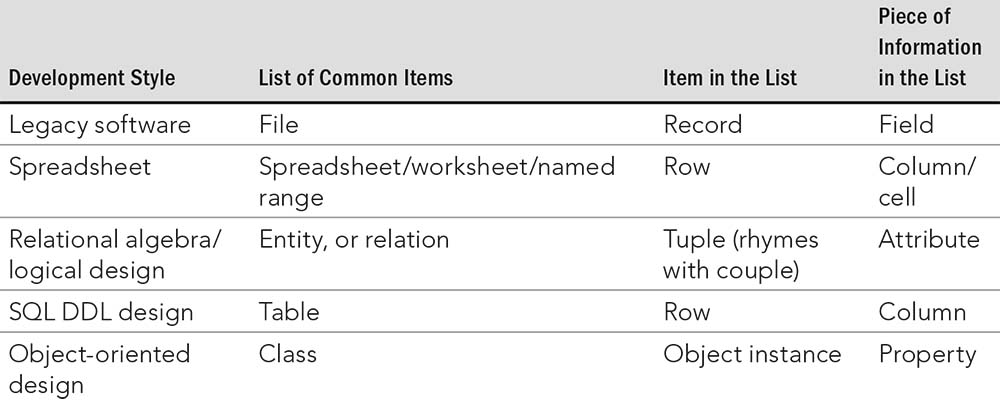
Comparing Database Terms
Development Style List of Common Items Item in the List Piece of Information in the List Legacy software File Record Field Spreadsheet Spreadsheet/worksheet/named range Row Column/cell Relational algebra/logical design Entity, or relation Tuple (rhymes with couple) Attribute SQL DDL design Table Row Column Object-oriented design Class Object instance Property
SQL Server developers generally refer to database elements as tables, rows, and columns when discussing the SQL Data Defi nition Language (DDL) layer or physical schema and sometimes use the terms entity, tuple, and attribute when discussing the logical design. The rest of this book uses the SQL terms (table, row, and column), but this chapter is devoted to the theory behind the design, so the relational algebra terms (entity, tuple, and attribute) are also used. A table row is a collection of columns that comprise an information unit. A record is a representation of an object. The specifics of the distinction between rows and records are best left to the theorists. It can be confusing though. For example, query results are stored in a recordset object, implying it is storing a set of records. However, it's really storing a result set, which by its definition, represents all the rows and columns resulting from a query. The following is right out of Microsoft documentation on the recordset object: "As its name implies, the Recordset object has features that you can use, depending on your query constraints, for retrieving and displaying a set of database rows, or records." For practical purposes, they're the same thing.
Columns are sorted in ascending order by default in SQL-Server
Note: unless otherwise specified, columns will be sorted in ascending order by default. Suppose you want to sort the VirtualBookShelf.com BookTable by title. The following SELECT statement does just that and returns the columns in ascending order:
SELECT * FROM BookTable ORDER BY Author
Notice that the ORDER BY clause comes at the end of a query.
In SQL Server 2022", columns in the result set will be sorted in "ascending order" by default when you use the `ORDER BY` clause without specifying a sort direction.
Explanation: When you use the `ORDER BY` clause and do not specify `ASC` (ascending) or `DESC` (descending), "ascending order" is the default behavior in SQL Server.
Example:SELECT FirstName, LastName FROM Employees ORDER BY LastName;
The above query will sort the `LastName` column in "ascending order" by default, equivalent to:
SELECT FirstName, LastName FROM Employees ORDER BY LastName ASC;
-
Ascending Order:
- Numerical values: Sorted from smallest to largest.
- Text: Alphabetical order (case-insensitive unless a specific collation is used).
- Dates: Oldest to newest.
-
Descending Order:
- You must explicitly use the
DESCkeyword in theORDER BYclause to sort in descending order.
- You must explicitly use the
The following series of images shows this statement in action:
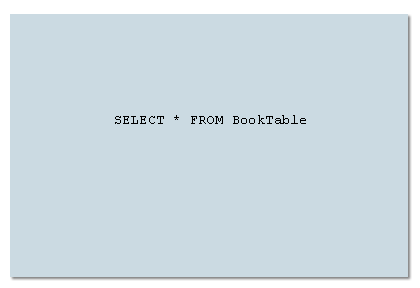
1) SELECT * FROM BookTable
This SELECT statement returns the table in the same order as the rows that appear in the table.
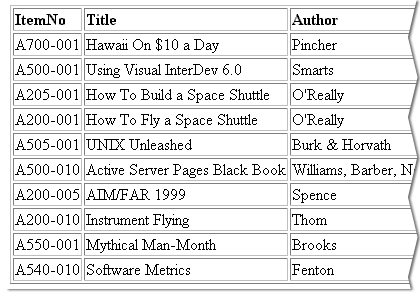
2) The results look like this in the Web browser. Notice the records appear in no specific order other than how they appear in the table.
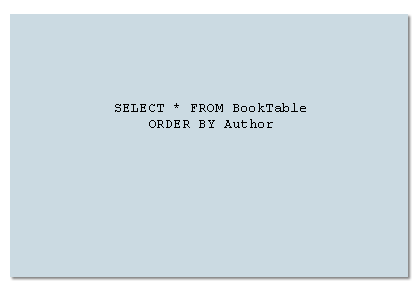
3) SELECT * FROM BookTable ORDER BY Author
This statement uses the ORDER BY clause to sort the rows by the author's name
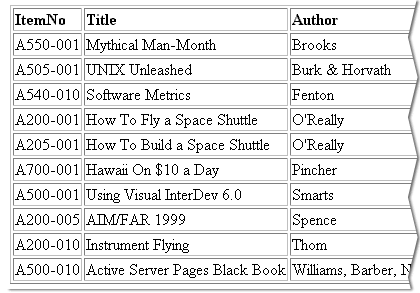
4)Now the table is displayed in ascending order by the author's name

5) The ORDER BY clause will also sort multiple columns. To do this, simply separate the column names by a comma. The ORDER BY clause in this statement specifies that the results be sorted first by Author, then by Title.
SELECT * FROM BookTable ORDER By Author, Title
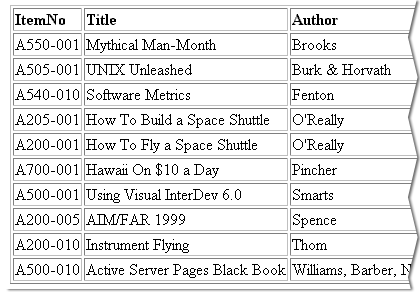
6) Here are the results displayed in the browser.
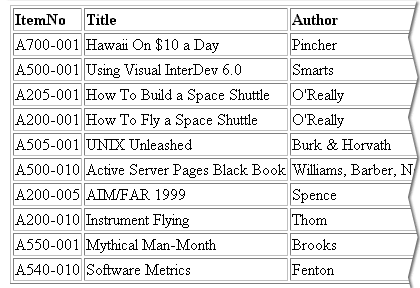
7) In some cases you might want to sort the output in descending order. To do this, add the expression DESC just after the column name. Even though ascending order is the default, you can specify ascending order in the ORDER BY clause by adding ASC after the column name. Here is the unsorted BookTable.
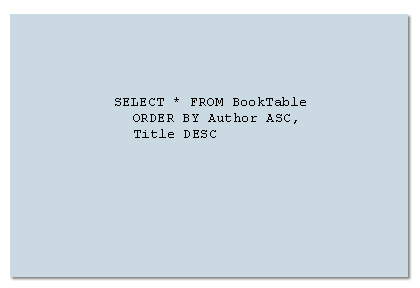
8) The ORDER BY clause instructs the statement to sort the Author colum in ascending order and the Title column in descending order. The use of ASC is optional because ascending is the default sort order.
SELECT * FROM BookTable ORDER BY Author ASC, Title DESC
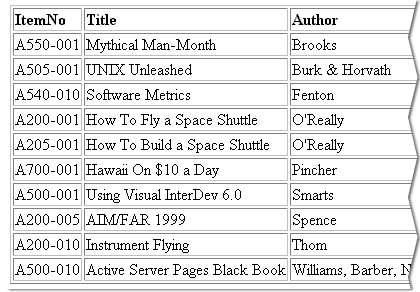
9) Here is the table after the sort
ORDER BY Clause (Transact-SQL)
Sorts data returned by a query in SQL Server. Use this clause to:- Order the result set of a query by the specified column list and, optionally, limit the rows returned to a specified range. The order in which rows are returned in a result set are not guaranteed unless an ORDER BY clause is specified.
- Determine the order in which ranking function values are applied to the result set.
ORDER BY order_by_expression [ COLLATE collation_name ] [ ASC | DESC ] [ ,...n ] [ <offset_fetch> ] <offset_fetch> ::= { OFFSET { integer_constant | offset_row_count_expression } { ROW | ROWS } [ FETCH { FIRST | NEXT } {integer_constant | fetch_row_count_expression } { ROW | ROWS } ONLY ] }
The syntax for the SQL `ORDER BY`adheres to modern SQL standards. Below is an explanation of its components:
Syntax Breakdown
-
ORDER BY order_by_expression
Specifies the column or expression by which to sort the query results. -
[ COLLATE collation_name ]
Specifies a collation for the sorting if the column is of a character data type. -
[ ASC | DESC ]
Specifies the sort direction:ASCfor ascending (default).DESCfor descending.
-
[ , ... n ]
Allows sorting by multiple columns or expressions, separated by commas. -
<offset_fetch> Clause
Provides advanced pagination capabilities:-
OFFSET { integer_constant | offset_row_count_expression } { ROW | ROWS }
Specifies the number of rows to skip before starting to return rows.ROWis equivalent toROWS.
-
FETCH { FIRST | NEXT } { integer_constant | fetch_row_count_expression } { ROW | ROWS } ONLY
Specifies the number of rows to return after the offset.FIRSTandNEXTare interchangeable.ONLYis mandatory to indicate that only the specified number of rows will be returned.
-
OFFSET { integer_constant | offset_row_count_expression } { ROW | ROWS }
SELECT column1, column2 FROM table_name ORDER BY column1 COLLATE Latin1_General_CI_AS DESC, column2 ASC OFFSET 10 ROWS FETCH NEXT 5 ROWS ONLY;
- Orders the rows based on
column1(descending) andcolumn2(ascending). - Skips the first 10 rows.
- Fetches the next 5 rows.
- The
OFFSETandFETCHclauses are supported in SQL:2008 standard and later, as well as in most modern RDBMS like SQL Server, PostgreSQL, and Oracle. - If
OFFSETis not specified, it defaults toOFFSET 0 ROWS. COLLATEis optional and applies only to string sorting based on collation rules.
Order By Clause - Exercise
Click the Exercise link below to practice using the ORDER BY clause.
Order By Clause - Exercise
In the next lesson, you will modify rows using the UPDATE statement.
-
Ascending Order: